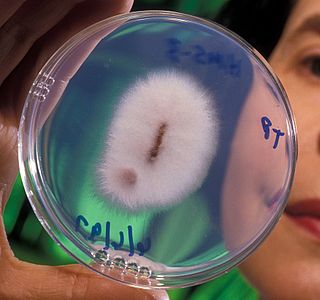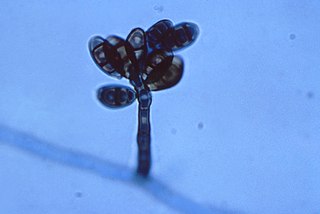
Ascomycota is a phylum of the kingdom Fungi that, together with the Basidiomycota, forms the subkingdom Dikarya. Its members are commonly known as the sac fungi or ascomycetes. It is the largest phylum of Fungi, with over 64,000 species. The defining feature of this fungal group is the "ascus", a microscopic sexual structure in which nonmotile spores, called ascospores, are formed. However, some species of Ascomycota are asexual and thus do not form asci or ascospores. Familiar examples of sac fungi include morels, truffles, brewers' and bakers' yeast, dead man's fingers, and cup fungi. The fungal symbionts in the majority of lichens such as Cladonia belong to the Ascomycota.

A hypha is a long, branching, filamentous structure of a fungus, oomycete, or actinobacterium. In most fungi, hyphae are the main mode of vegetative growth, and are collectively called a mycelium.

Sordaria fimicola is a species of microscopic fungus. It is commonly found in the feces of herbivores. Sordaria fimicola is often used in introductory biology and mycology labs because it is easy to grow on nutrient agar in dish cultures. The genus Sordaria, closely related to Neurospora and Podospora, is a member of the large class Sordariomycetes, or flask-fungi. The natural habitat of the three species of Sordaria that have been the principal subjects in genetic studies is dung of herbivorous animals. The species S. fimicola is common and worldwide in distribution. The species of Sordaria are similar morphologically, producing black perithecia containing asci with eight dark ascospores in a linear arrangement. These species share a number of characteristics that are advantageous for genetic studies. They all have a short life cycle, usually 7–12 days, and are easily grown in culture. Most species are self-fertile and each strain is isogenic. All kinds of mutants are easily induced and readily obtainable with particular ascospore color mutants. These visual mutants aid in tetrad analysis, especially in analysis of intragenic recombination.

The fungus Cochliobolus sativus is the teleomorph of Bipolaris sorokiniana (anamorph) which is the causal agent of a wide variety of cereal diseases. The pathogen can infect and cause disease on roots, leaf and stem, and head tissue. C. sativus is extremely rare in nature and thus it is the asexual or anamorphic stage which causes infections. The two most common diseases caused by B. sorokiniana are spot blotch and common root rot, mainly on wheat and barley crops.

The fungal genus Cochliobolus includes 19 species, it includes some plant pathogenic species such as Cochliobolus heterostrophus. A lot of former Cochliobolus species were transferred to either Curvularia or Bipolaris genera.

Fusarium oxysporum f.sp. ciceris is a fungal plant pathogen that causes fusarium wilt of chickpea.
Alternaria carthami is a necrotrophic plant pathogen of safflower. The fungus is in the order Pleosporales and family Pleosporaceae. It was first isolated in India, has spread globally and can have devastating effects on safflower yield, and resultant oilseed production. A. carthami is known to be seed-borne and appears as irregular brown lesions on safflower leaves and stems.

Cochliobolus carbonum is one of more than 40 species of filamentous ascomycetes belonging to the genus Cochliobolus. This pathogen has a worldwide distribution, with reports from Australia, Brazil, Cambodia, Canada, China, Congo, Denmark, Egypt, India, Kenya, New Zealand, Nigeria, Solomon Islands, and the United States. Cochliobolus carbonum is one of the most aggressive members of this genus infecting sorghum, corn and apple. As one of the most devastating pathogens of sweet corn, C. carbonum causes Northern leaf spot and ear rot disease while the asexual stage causes Helminthosporium corn leaf spot. Cochliobolus carbonum is pathogenic to all organs of the corn plant including root, stalk, ear, kernel, and sheath. However, symptoms of infection show distinct manifestations in different plant parts: whole plant - seedling blight affects the whole plant, leaf discoloration and mycelial growth, black fungal spores and lesions appear on inflorescences and glumes, and grain covered with very dark brown to black mycelium which gives a characteristic charcoal appearance due to the production of conidia.

Cochliobolus lunatus is a fungal plant pathogen that can cause disease in humans and other animals. The anamorph of this fungus is known as Curvularia lunata, while C. lunatus denotes the teleomorph or sexual stage. They are, however, the same biological entity. C. lunatus is the most commonly reported species in clinical cases of reported Cochliobolus infection.
Magnaporthe salvinii is a fungus known to attack a variety of grass and rice species, including Oryza sativa and Zizania aquatica. Symptoms of fungal infection in plants include small, black, lesions on the leaves that develop into more widespread leaf rot, which then spreads to the stem and causes breakage. As part of its life cycle, the fungus produces sclerotia that persist in dead plant tissue and the soil. Management of the fungus may be effected by tilling the soil, reducing its nitrogen content, or by open field burning, all of which reduce the number of sclerotia, or by the application of a fungicide.

Cladosporium sphaerospermum is a radiotrophic fungus belonging to the genus Cladosporium and was described in 1886 by Albert Julius Otto Penzig from the decaying leaves and branches of Citrus. It is a dematiaceous (darkly-pigmented) fungus characterized by slow growth and largely asexual reproduction. Cladosporium sphaerospermum consists of a complex of poorly morphologically differentiated, "cryptic" species that share many physiological and ecological attributes. In older literature, all of these sibling species were classified as C. sphaerospermum despite their unique nature. Accordingly, there is confusion in older literature reports on the physiological and habitat regularities of C. sphaerospermum in the strict sense. This fungus is most phylogenetically similar to C. fusiforme. According to modern phylogenetic analyses, the previously synonymized species, Cladosporium langeroni, is a distinct species.
Pithomyces chartarum is a fungus predominantly found in subtropical countries and other localities with warmer climates. However, it occurs throughout the world including the United Kingdom, Europe and Netherlands. Pithomyces chartarum produces a mycotoxin called sporidesmin when it grows on plants, particularly grasses. Presence of the toxin in forage grasses causes facial eczema in sheep, and is especially problematic in areas such as New Zealand where sheep are intensively raised. Other health effect of P. chartarum are not well understood.
Curvularia pallescens is a soil fungus, that commonly grows on crops found in tropical regions. The conidia of the fungus are distinguishable from those of related species due to their lack of curvature. C. pallescens has been reported to cause infection in plants, and in immunocompetent individuals. This species is the anamorph of Cochliobolus pallescens.
Botryotrichum piluliferum is a fungal species first identified in 1885 by Saccardo and Marchal. It was discovered to be the asexual state of a member of the ascomycete genus, Chaetomium. The name B. piluliferum now applies to the fungus in all its states. B. piluliferum has been found worldwide in a wide range of habitats such as animal dung and vegetation. The colonies of this fungus start off white and grow rapidly to a brown colour. The conidia are smooth and white. B. piluliferum grows optimally at a temperature of 25–30 °C and a pH of 5.5.
Microascus manginii is a filamentous fungal species in the genus Microascus. It produces both sexual (teleomorph) and asexual (anamorph) reproductive stages known as M. manginii and Scopulariopsis candida, respectively. Several synonyms appear in the literature because of taxonomic revisions and re-isolation of the species by different researchers. M. manginii is saprotrophic and commonly inhabits soil, indoor environments and decaying plant material. It is distinguishable from closely related species by its light colored and heart-shaped ascospores used for sexual reproduction. Scopulariopsis candida has been identified as the cause of some invasive infections, often in immunocompromised hosts, but is not considered a common human pathogen. There is concern about amphotericin B resistance in S. candida.
Curvularia inaequalis is a plant saprobe that resides in temperate and subtropical environments. It is commonly found in the soils of forage grasses and grains. The species has been observed in a broad distribution of countries including Turkey, France, Canada, The United States, Japan and India. This species is dematiaceous and a hyphomycete.

Curvularia geniculata is a fast-growing anamorphic fungus in the division Ascomycota, most commonly found in soil, especially in areas of warmer climates. The fungus is a pathogen, mainly causing plant and animal infections, and rarely causing human infections. C. geniculata is characterized by its curved conidia, which has a dark brown centre and pale tapered tips, and produces anti-fungal compounds called Curvularides A-E.

Xenodevriesia strelitziicola is a pathogenic ascomycete fungus in the class Dothideomycetes that infects the South African plant Strelitzia. It is the only species of the monotypic genus Xenodevriesia and family Xenodevriesiaceae.
Meristacrum is a fungal genus in the monotypic family Meristacraceae, of the order Entomophthorales. They are parasites of soil invertebrates, they typically infect nematodes, and tardigrades.












